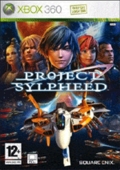You can trust VideoGamer. Our team of gaming experts spend hours testing and reviewing the latest games, to ensure you're reading the most comprehensive guide possible. Rest assured, all imagery and advice is unique and original. Check out how we test and review games here
If any two-dimensional shooter (or shmup) was likely to turn its back on its past and evolve into a fully fledged 3D space combat game, it was always going to be the Silpheed titles. The middling quality shmup quickly adopted a partly third-dimensional top-down viewpoint when the technology made it available and, unlike most of its genre mates, it was always concerned with lengthy cut-scenes, text heavy storytelling and an HUD modelled on that of flight-sims.
Still, it is a surprise to see the series not only make a huge sideways step in terms of gameplay, but also move to Square Enix; a company far from renowned for shooters. Yet it was the Final Fantasy publisher who was behind the legendry PS1 shmup Einhander, and some of their ability is evident here, though Silpheed fans hoping for more of the same from Project Sylpheed are likely to feel a mixed reaction to this major reworking that does a lot more than change a letter in the game’s title.
In taking the leap from one niche genre to another, Project Sylpheed still retains much of the style of its predecessor. Everything from the gently garish glowing colour schemes to the thick, syrupy feel of space is in place. The overall aesthetic of this newest game is largely familiar, right down to the babbling radio chatter that fills the background, keeping to the feel of its forefathers. Most of the ships are identical, and even some of the explosions from the PlayStation 2 version of the lumbering shmup have made it through to the newest incarnation of the Silpheed universe.
The gameplay, however, is vastly different. Here space combat goes Ace Combat, and though there are some parallels to be drawn with the likes of Wing Commander, everything form the mission objectives and feel of control through to the acrobatics and cut-scene styling constantly reminds of Namco’s fantastic dog fighting game, including the aforementioned radio chatter.
While Project Sylpheed isn’t anywhere near as refined as Ace Combat, the pleasant surprise is that it is rather good. Shmup fans were certainly expecting it to be awful, and its rather quiet release pointed to a title that was headed straight to the bottom of bargain bins. While that still might be Project Sylpheed’s destiny, it won’t be deserved.
After some distinctly average cut scenes that are moderately well produced but utterly throwaway, the action begins in earnest, and it must be said that it is very pretty for a game that lacks much in real graphical polish. The HUD may be a little overwhelming and some will feel the game’s playing areas become cluttered, but the radiant vapours left by the dozens of ships and missiles that fill the sky turn huge vacant areas of the cosmos into tangled webs of gently shimmering blue and red. Theynot only look like the creation of an eccentric experiment inside a master villain’s glass ball, but also work as navigational guides and a way of tracking your enemies.
Most of the missions do revolve around protecting your painfully lazy mother ship by blasting everything that moves out of the sky, but despite your craft’s slow speed the action is fairly fast paced and intense, and you rarely get even a second to let down your guard.
The B-button is used to activate snappy evasive manoeuvres like barrel rolls and split turns, and despite a fairly demanding control set-up you’ll soon be simultaneously locking missiles onto foes, unleashing the payload of your nose-mounted cannon and dodging the intertwined labyrinth of lasers as you dance death above distant planets.
Each battleground is filled with huge static space stations from both sides of the convoluted conflict, meaning the air is heavy with think slices of neon laser, that somehow add a touch of the feel of a shmup, but perhaps the closest gameplay mechanic to the game’s two-dimensional forefather is the patience stretching difficulty. It’s not that the game is especially tricky, but the continue structure is extremely testing.
As with the Silpheed games, most of Project Sylpheed’s 16 levels are broken down into sections, and while they can be used as restart points after the loss of a life, they cannot be used as save points. With all the lives the game pushes you to use, this can mean sitting down for a bit of thumb twitching often involves lengthy stints of repeat playing levels, which is painful to say the least.
However, three-dimensional space games and flight-sims are a dying breed in the current climate, and in terms of gameplay, Project Sylpheed cruises some way above average.
/https://oimg.videogamer.com/images/a8bb/project_sylph_4.jpg)






